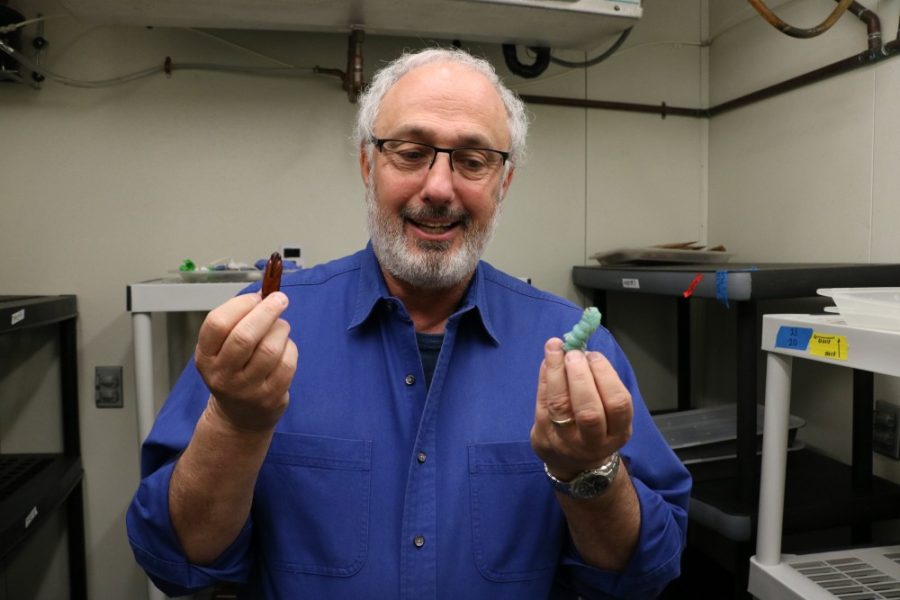UA researchers recently discovered that nectar-eating organisms, such as moths, are using their sugary diet to their advantage.
The discovery was spurred by what Goggy Davidowitz, an associate professor in the Department of Entomology, and his team thought was flawed data.
At the time, Davidowitz’s team was studying respiratory quotient in a type of insect called the hawk moth, when they began to record data that didn’t seem right.
A data problem
Respiratory quotient (RQ) is the volume of carbon dioxide an organism produces over the volume of oxygen the organism consumes; the number helps determine the creature’s metabolism. RQ can vary based on the diet of the organism but should never go above 1.
“We all know that the RQ is bounded on the low side by 0.7 and on the top by 1,” Davidowitz said. “But when we were measuring it in the lab, we were getting 1.5, 1.4 or 1.8.”
Davidowitz assumed there was a problem with the research machinery, which included a round chamber called a flight mill, that measured the metabolic cost of flight, and an oxygen analyzer.
After communicating with the equipment manufacturer, the team thought they had solved the problem. However, as the experiments continued, Davidowitz’s lab once again obtained RQ values that were above the established norm.
This wasn’t the first time that an experiment of this nature had gathered unusual RQ values. Indeed, other papers on the topic show RQ values clearly above 1.
“Nobody talks about it, everybody who does this kind of stuff just says ‘Oh, it’s just a technological limitation of the machines,’ but we all know, theoretically, that it can’t be above 1,” Davidowitz said.
Davidowitz gave the task of determining what was causing these abnormalities to postdoctoral researcher Eran Levin. Through a series of experiments, Levin made a breakthrough. The abnormal data was caused by an actual biological factor, not a technical malfunction.
RELATED: Food for bees: Foraging patterns in bumblebees
Biological problem solving
Davidowitz then set to work on understanding what kind of factor was at play.
“That’s how this whole thing came about,” Davidowitz said. The team began to investigate metabolic pathways—biological processes that break down food to be used as energy—as a possible answer for their high RQ.
To test their theory, Davidowitz’s team combined their usual oxygen and carbon dioxide analyzers with an isotope analyzer—a machine capable of offering detailed information about the carbon produced by their hawk moth subjects. The isotope analyzer allowed the team to see where in their bodies the moths were distributing their sugary food.
“As far as I know, I’m the only lab in the world doing this,” Davidowitz said. “We can measure this stuff in real time.”
For nectar-feeders such as hawk moths, metabolizing energy is a matter of life and death.
“The more you exercise, the higher your metabolism go, you [begin to] produce what are called oxygen-free radicals,” Davidowitz said.
Radicals are a reactive chemical that are dangerous to cells, as they are capable of degrading cell walls and DNA.
For people, the solution during exercise is to consume antioxidants, chemicals which can fight off oxygen-free radicals.
In the animal kingdom, migrating birds often stop and eat berries to get their antioxidants.
RELATED: Biologists find key traits for species success
The explanation
Hawk moths and other nectar-feeding organisms–such as butterflies and hummingbirds–often hover, which is metabolically expensive. Additionally, organisms such as these are unable to get antioxidants through their typical diet. Davidowitz hoped to figure out what these organisms do to ward off oxygen-free radicals.
By using the isotope analyzer and determining the specific distribution of nutrients, the researchers discovered that hawk moths use a different metabolic pathway than normal to process sugar. Rather than pushing the sugar through the Krebs cycle—the process used to produce energy—the moths switch to what is called the pento phosphate pathway.
In the pento phosphate pathway, the moths themselves produce antioxidants to fight off oxygen-free radicals. Such progress begins immediately after flight.
“The second they stop flapping, they start shunting to the pento phosphate pathway,” Davidowitz said.
This allows the moths to produce enough antioxidants to negate the damage they caused their body during flight, all without having to ingest other foods.
This pathway isn’t unique to organisms that survive on sugar and has been acknowledged by the scientific community for a long time; animals such as hawk moths simply apply the process more often.
“It’s very possible that a lot of organisms are doing this. It’s just that nobody thought of looking at it,” Davidowitz said.
Davidowitz considers this experiment to be a “story of science.”
“This is the way science works a lot,” Davidowitz said. “You go in a particular direction, it fizzles out, and then you try something else.”
Learn more about the Davidowitz lab’s research online.
Follow Nicole Morin on Twitter.











